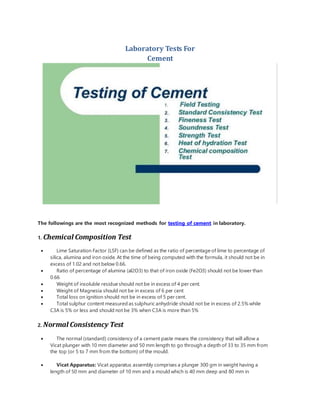TESTING OF CEMENT IN LABORATORY
- 1. Laboratory Tests For Cement The followings are the most recognized methods for testing of cement in laboratory. 1. Chemical Composition Test ï‚· Lime Saturation Factor (LSF) can be defined as the ratio of percentage of lime to percentage of silica, alumina and iron oxide. At the time of being computed with the formula, it should not be in excess of 1.02 and not below 0.66. ï‚· Ratio of percentage of alumina (al2O3) to that of iron oxide (Fe2O3) should not be lower than 0.66 ï‚· Weight of insoluble residue should not be in excess of 4 per cent. ï‚· Weight of Magnesia should not be in excess of 6 per cent ï‚· Total loss on ignition should not be in excess of 5 per cent. ï‚· Total sulphur content measured as sulphuric anhydride should not be in excess of 2.5% while C3A is 5% or less and should not be 3% when C3A is more than 5% 2. Normal Consistency Test ï‚· The normal (standard) consistency of a cement paste means the consistency that will allow a Vicat plunger with 10 mm diameter and 50 mm length to go through a depth of 33 to 35 mm from the top (or 5 to 7 mm from the bottom) of the mould. ï‚· Vicat Apparatus: Vicat apparatus assembly comprises a plunger 300 gm in weight having a length of 50 mm and diameter of 10 mm and a mould which is 40 mm deep and 80 mm in
- 2. diameter. 3. Initial Setting Time Test After adding the water to cement, the subsequent paste gets solidified and attains strength and as a result the consistency is reduced concurrently. The term setting means hardening of the plastic cement paste. Initial and final setting times are considered as the two hardening conditions ofthe cement. The beginning of condensation is known as the initial set, marks the point in time while the paste is inoperative. ï‚· Initial setting time should not be lower than 30 minutes for OPC and 60 minutes for low heat cement. 4. Final Setting Time Test The final setting time indicates the time after which the paste gets stiff so that the angular attachment to the needle, under standard weight, can't provide any mark on the hardened concrete. Initial and final setting times belong to the rheological properties of cement. ï‚· The final setting time should not be in excess of 10 hours. 5. Soundness Test ï‚· To find out the soundness of cement 'Le Chatelier's method' or 'Autoclave' test are conducted. ï‚· There is no proper test for deduction of soundness because of the existence of excessive calcium sulphate. But its content is easily determined with chemical analysis. ï‚· 6. Strength Test (a) Compressive Strength Test ï‚· To determine the compressive strength, three cubes are tested at 1 day, 3 day, 7 days and 28 day where the period of testing is calculated once the vibration is finished. ï‚· The compressive strength should be the average of the strengths of the three cubes for each period correspondingly. ï‚· The compressive strength of 33 grade OPC at 3 day and 28 day is 16 MPa, 22 MPa and 33 MPa correspondingly. (b) Tensile Strength Test ï‚· Six briquettes are tested and average tensile strength is calculated. ï‚· A load is applied steadily and uniformly, starting from zero and increasing at the rate of0.7 N/mm2 in 12 seconds. ï‚· OPC should have a tensile strength of not less than 2 MPa and 2.5 MPa after 3 and 7 days respectively. ï‚· Normally, the tensile strength should be 10-15% of compressive strength.
- 3. 7. Fineness Test: The following three methods are mostly recognized for testing fineness. (a) Sieve Method ï‚· 100 gm of cement sample is chosen and the sample are smashed with fingers for any air set lumps. ï‚· The sample is provided on a 90 micron sieve and constantly sieved for 15 minutes. ï‚· The residue should not go beyond the limits indicated below: Ordinary Portland Cement - 10 (residue/weight) Rapid hardening Cement - 5 (residue/weight) Portland Pozzolana Cement - 5 (residue/weight) (b) Air Permeability Method ï‚· Fineness of cement is denoted with specific surface i.e. total surface area in cm2 per gram of cement. (c) Wagner Turbidimeter Test ï‚· The cement is spread equally in a rectangular glass tank filled with kerosene. ï‚· Parallel light rays are passed through the solution that hits the sensitivity plate of a photoelectric cell. 8. Heat of hydration Test ï‚· The heat of hydration of cement is decided by the apparatus called as calorimeter. ï‚· The heat of hydration for low heat Portland cement should not be in excess of 66 and 75 cal/gm for 7 and 28 days correspondingly. 9. Specific Gravity Test ï‚· The specific gravity of cement is determined with Le Chatelier's flask. To get more informative civil engineeringarticle,tutorialsand videos;visitmy website http://www.constructionnews.co.in/ Like my facebookpage https://www.facebook.com/sketchup3dconstruction


